Deck 19: Electric Currents and Circuits
Question
Question
Question
Question
Question
Question
Question
Question
Question
Question
Question
Question
Question
Question
Question
Question
Question
Question
Question
Question
Question
Question
Question
Question
Question
Question
Question
Question
Question
Question
Question
Question
Question
Question
Question
Question
Question
Question
Question
Question
Question
Question
Question
Question
Question
Question
Question
Question
Question
Question
Question
Question
Question
Question
Question
Question
Question
Question
Question
Question
Question
Question
Question
Question
Question
Question
Question
Question
Question
Question
Question
Question
Question
Question
Question
Question
Question
Question
Question
Question

Unlock Deck
Sign up to unlock the cards in this deck!
Unlock Deck
Unlock Deck
1/115
Play
Full screen (f)
Deck 19: Electric Currents and Circuits
1
When an electric current exists within a conducting wire, which of the following statements describes the condition of any accompanying electric field?
A) must be perpendicular to current flow
B) must be parallel to current flow
C) must be zero
D) must be anti-parallel (opposite direction) to current flow
A) must be perpendicular to current flow
B) must be parallel to current flow
C) must be zero
D) must be anti-parallel (opposite direction) to current flow
must be parallel to current flow
2
You measure a 20.0-V potential difference across a 5.00- resistor. What is the current flowing through it?
A) 5.00 A
B) 4.00 A
C) 100 A
D) 1.00 A
A) 5.00 A
B) 4.00 A
C) 100 A
D) 1.00 A
4.00 A
3
Two wires with the same resistance have the same diameter but different lengths. If wire 1 has length L1 and wire 2 has length L2, how do L1 and L2 compare if wire 1 is made from copper and wire 2 is made from aluminum? The resistivity of copper is 1.7 *10-5 ·m and the resistivity of aluminum is 2.82 *10-5 ·m.
A) L1 = 0.36 L2
B) L1 = 2.8 L2
C) L1 = 0.60 L2
D) L1 = 1.7 L2
A) L1 = 0.36 L2
B) L1 = 2.8 L2
C) L1 = 0.60 L2
D) L1 = 1.7 L2
L1 = 1.7 L2
4
The current in an electron beam in a cathode-ray tube is measured to be 280 µA. How many electrons hit the screen in 50 s? (e = 1.6 *10 - 19 C)
A) 2.2 * 1011 electrons
B) 8.8 * 1016 electrons
C) 8.8* 1015 electrons
D) 2.2 * 1015 electrons
A) 2.2 * 1011 electrons
B) 8.8 * 1016 electrons
C) 8.8* 1015 electrons
D) 2.2 * 1015 electrons

Unlock Deck
Unlock for access to all 115 flashcards in this deck.
Unlock Deck
k this deck
5
A 12.6-V battery supplies a 2.0-A current for 2.0 minutes. What is the work done by the battery during this process?
A) 0 J
B) 3.0 * 103 J
C) 2.5 *102 J
D) 1.5 *104 J
A) 0 J
B) 3.0 * 103 J
C) 2.5 *102 J
D) 1.5 *104 J

Unlock Deck
Unlock for access to all 115 flashcards in this deck.
Unlock Deck
k this deck
6
Wire A and Wire B are each carrying the same current. If the diameter of Wire A is half that of Wire B, how does the drift velocity vdA in Wire A compare to that in Wire B?
A) vdA = 4 vdB
B) vdA = 2 vdB
C) vdA = vdB /2
D) vdA = vdB /4
A) vdA = 4 vdB
B) vdA = 2 vdB
C) vdA = vdB /2
D) vdA = vdB /4

Unlock Deck
Unlock for access to all 115 flashcards in this deck.
Unlock Deck
k this deck
7
In a certain material there is a current of 16 A flowing through a surface to the left, and there is an equal amount of positive and negative charge passing through the surface producing the current. How much negative charge passes through the surface?
A) 16 C/s toward the left
B) 16 C/s toward the right
C) 8 C/s toward the right
D) 8 C/s toward the left
A) 16 C/s toward the left
B) 16 C/s toward the right
C) 8 C/s toward the right
D) 8 C/s toward the left

Unlock Deck
Unlock for access to all 115 flashcards in this deck.
Unlock Deck
k this deck
8
The size of the electric current in a electrical conductor is a function of which of the following?
A) conductor cross sectional area
B) velocity of charge carriers
C) density of charge carriers
D) All of these choices are valid.
A) conductor cross sectional area
B) velocity of charge carriers
C) density of charge carriers
D) All of these choices are valid.

Unlock Deck
Unlock for access to all 115 flashcards in this deck.
Unlock Deck
k this deck
9
Two cylindrical resistors are made of the same material and have the same resistance. The resistors, R1 and R2, have different radii, r1 and r2, and different lengths, L1 and L2. Which of the following relative values for radii and lengths would result in equal resistances?
A) r1 = r2 and 4L1 = L2
B) r1 = r2 and L1 = 2L2
C) 2r1 = r2 and 4L1 = L2
D) 2r1 = r2 and L1 = 2L2
A) r1 = r2 and 4L1 = L2
B) r1 = r2 and L1 = 2L2
C) 2r1 = r2 and 4L1 = L2
D) 2r1 = r2 and L1 = 2L2

Unlock Deck
Unlock for access to all 115 flashcards in this deck.
Unlock Deck
k this deck
10
If a metallic wire of cross-sectional area 3.0 *10 - 6 m2 carries a current of 9.1 A and has a mobile charge density of 4.24 * 1028 carriers/m3, what is the average drift velocity of the mobile charge carriers? (charge value = 1.6 *10 - 19 C)
A) 3.4 * 103 m/s
B) 1.7 * 103 m/s
C) 4.5*10 - 4 m/s
D) 1.5 *10 - 4 m/s
A) 3.4 * 103 m/s
B) 1.7 * 103 m/s
C) 4.5*10 - 4 m/s
D) 1.5 *10 - 4 m/s

Unlock Deck
Unlock for access to all 115 flashcards in this deck.
Unlock Deck
k this deck
11
How long is a wire made from 200 cm3 of copper if its resistance is 8.5 ohms? The resistivity of copper is 1.7 *10-5 ·m.
A) 10 m
B) 2.2 *102 m
C) 7.1 m
D) 3.0 *103 m
A) 10 m
B) 2.2 *102 m
C) 7.1 m
D) 3.0 *103 m

Unlock Deck
Unlock for access to all 115 flashcards in this deck.
Unlock Deck
k this deck
12
When you flip a switch to turn on a light, the delay before the light turns on is determined by:
A) the speed of the electric field moving in the wire.
B) the drift speed of the electrons in the wire.
C) the number of electron collisions per second in the wire.
D) none of these, since the light comes on instantly.
A) the speed of the electric field moving in the wire.
B) the drift speed of the electrons in the wire.
C) the number of electron collisions per second in the wire.
D) none of these, since the light comes on instantly.

Unlock Deck
Unlock for access to all 115 flashcards in this deck.
Unlock Deck
k this deck
13
A lightbulb drawing a current of 0.60 A is run for 2.0 hours. How many electrons pass through the bulb during this process?
A)
B)
C)
D)
A)

B)

C)

D)


Unlock Deck
Unlock for access to all 115 flashcards in this deck.
Unlock Deck
k this deck
14
A metallic conductor has a resistivity of 18 *10 - 6 m. What is the resistance of a piece that is 15 m long and has a uniform cross sectional area of 6.0 *10 - 6 m2?
A) 0.056
B) 45
C) 90
D) 160
A) 0.056
B) 45
C) 90
D) 160

Unlock Deck
Unlock for access to all 115 flashcards in this deck.
Unlock Deck
k this deck
15
A Nichrome wire has a radius of 0.50 mm and a resistivity of 1.5 *10 - 6 m. If the wire carries a current of 1.0 A, what is the potential difference per unit length along this wire?
A) 1.9 V/m
B) 0.95 V/m
C) 1.6 V/m
D) 0.003 V/m
A) 1.9 V/m
B) 0.95 V/m
C) 1.6 V/m
D) 0.003 V/m

Unlock Deck
Unlock for access to all 115 flashcards in this deck.
Unlock Deck
k this deck
16
The unit of electric current, the ampere, is equivalent to which of the following?
A)" V/ "
B) "V/s"
C) " .m"
D) "V. "
A)" V/ "
B) "V/s"
C) " .m"
D) "V. "

Unlock Deck
Unlock for access to all 115 flashcards in this deck.
Unlock Deck
k this deck
17
A 300-A·h battery can deliver how many coulombs starting from a full charge?
A) 4.8 * 103
B) 4.3 * 104
C) 7.2 * 105
D) 1.1 * 106
A) 4.8 * 103
B) 4.3 * 104
C) 7.2 * 105
D) 1.1 * 106

Unlock Deck
Unlock for access to all 115 flashcards in this deck.
Unlock Deck
k this deck
18
A 0.10-m long metal rod has a radius of 1.0 cm and a resistance of 3.2 * 10 - 5 . What is the resistivity of the metal?
A) 5.0 *10 - 8 .m
B) 160*10 - 8 .m
C) 10 *10 - 8 .m
D) 1.6 *10 - 8 .m
A) 5.0 *10 - 8 .m
B) 160*10 - 8 .m
C) 10 *10 - 8 .m
D) 1.6 *10 - 8 .m

Unlock Deck
Unlock for access to all 115 flashcards in this deck.
Unlock Deck
k this deck
19
If the current in a wire is halved, what effect does this have on the electron drift velocity in the wire?
A) It decreases by a factor of two.
B) It increases by a factor of four.
C) It stays the same.
D) It doubles.
A) It decreases by a factor of two.
B) It increases by a factor of four.
C) It stays the same.
D) It doubles.

Unlock Deck
Unlock for access to all 115 flashcards in this deck.
Unlock Deck
k this deck
20
A wire carries a steady current of 0.1 A over a period of 200 s. What total charge passes through the wire in this time interval?
A) 2 C
B) 200 C
C) 0.005 C
D) 20 C
A) 2 C
B) 200 C
C) 0.005 C
D) 20 C

Unlock Deck
Unlock for access to all 115 flashcards in this deck.
Unlock Deck
k this deck
21
A 100-W light bulb is in a socket supplied with 120 V. What is the current in the bulb?
A) 7200 A
B) 0.83 A
C) 1.4 A
D) 0.50 A
A) 7200 A
B) 0.83 A
C) 1.4 A
D) 0.50 A

Unlock Deck
Unlock for access to all 115 flashcards in this deck.
Unlock Deck
k this deck
22
The unit for rate of energy transformation, the watt, in an electric circuit is equivalent to which of the following?
A) A.
B) V/s
C) V/
D) V.A
A) A.
B) V/s
C) V/
D) V.A

Unlock Deck
Unlock for access to all 115 flashcards in this deck.
Unlock Deck
k this deck
23
A high-voltage transmission line carries 500 A at 700,000 V. What is the power carried by the line?
A) 100 MW
B) 350 MW
C) 700 MW
D) 70 MW
A) 100 MW
B) 350 MW
C) 700 MW
D) 70 MW

Unlock Deck
Unlock for access to all 115 flashcards in this deck.
Unlock Deck
k this deck
24
A copper cable needs to carry a current of 200 A with a power loss of only 1.5 W/m. What is the required radius of the copper cable? (The resistivity of copper is 1.7 *10 - 8 m.)
A) 4.0 cm
B) 0.21 cm
C) 0.85 cm
D) 1.2 cm
A) 4.0 cm
B) 0.21 cm
C) 0.85 cm
D) 1.2 cm

Unlock Deck
Unlock for access to all 115 flashcards in this deck.
Unlock Deck
k this deck
25
A length L of wire has a voltage V across its ends while a current I runs through the wire. If a voltage 3V were applied to another length of this same wire from the same coil and the same current were found to run through it, what is the length of this second wire?
A)
B)
C)
D)
A)

B)

C)

D)


Unlock Deck
Unlock for access to all 115 flashcards in this deck.
Unlock Deck
k this deck
26
If a 9.0-V battery, with negligible internal resistance, and an 27- resistor are connected in series, what is the amount of electrical energy transformed to heat per coulomb of charge that flows through the circuit?
A) 0.50 J
B) 9.0 J
C) 3.0 J
D) 72 J
A) 0.50 J
B) 9.0 J
C) 3.0 J
D) 72 J

Unlock Deck
Unlock for access to all 115 flashcards in this deck.
Unlock Deck
k this deck
27
A high-voltage transmission line carries 500 A at 700 kV for a distance of 100 miles. If the resistance in the wire is 1 /mile, what is the power loss due to resistive losses?
A) 250 MW
B) 2.5 kW
C) 25 MW
D) 25 kW
A) 250 MW
B) 2.5 kW
C) 25 MW
D) 25 kW

Unlock Deck
Unlock for access to all 115 flashcards in this deck.
Unlock Deck
k this deck
28
An electric clothes dryer draws 20 A at 220 V. If the clothes put into the dryer have a mass of 7.0 kg when wet and 3.0 kg dry, how long does it take to dry the clothes? (Assume all heat energy goes into vaporizing water, Lv = 2.26 *106 J/kg.)
A) 55 min
B) 26 min
C) 16 min
D) 34 min
A) 55 min
B) 26 min
C) 16 min
D) 34 min

Unlock Deck
Unlock for access to all 115 flashcards in this deck.
Unlock Deck
k this deck
29
If a lamp has resistance of 120 when it operates at 200 W, what is the applied voltage?
A) 120 V
B) 220 V
C) 110 V
D) 155 V
A) 120 V
B) 220 V
C) 110 V
D) 155 V

Unlock Deck
Unlock for access to all 115 flashcards in this deck.
Unlock Deck
k this deck
30
A resistor is connected to a battery with negligible internal resistance. If you replace the resistor with one that has quadruple the resistance, by what factor does the power dissipated in the circuit change?
A) 0.25
B) 4.0
C) 2.0
D) 0.50
A) 0.25
B) 4.0
C) 2.0
D) 0.50

Unlock Deck
Unlock for access to all 115 flashcards in this deck.
Unlock Deck
k this deck
31
The quantity volt is equivalent to which of the following?
A) J/C
B) C/
C) J.C
D) J.m
A) J/C
B) C/
C) J.C
D) J.m

Unlock Deck
Unlock for access to all 115 flashcards in this deck.
Unlock Deck
k this deck
32
An electric car is designed to run off a bank of 12-V batteries with total energy storage of 6.0 *107 J. If the electric motor draws 6000 W in moving the car at a steady speed of 10 m/s, how far will the car go before it is "out of juice?"
A) 150 km
B) 50 km
C) 100 km
D) 25 km
A) 150 km
B) 50 km
C) 100 km
D) 25 km

Unlock Deck
Unlock for access to all 115 flashcards in this deck.
Unlock Deck
k this deck
33
A light bulb, sold as long-lasting, is rated 120 W at 130 V. The "increased" lifetime comes from using it at 120 V. Assuming negligible change in resistance at the different voltage, what is its power consumption at 120 V?
A) 92 W
B) 102 W
C) 108 W
D) 85 W
A) 92 W
B) 102 W
C) 108 W
D) 85 W

Unlock Deck
Unlock for access to all 115 flashcards in this deck.
Unlock Deck
k this deck
34
Ten coulombs of charge start from the negative terminal of a battery, flow through the battery and then leave the positive terminal through a wire, flow through a resistor, and then return to the starting point on this closed circuit. In this complete process, the ten coulombs:
A) receive heat energy from the resistor.
B) do positive work on the battery.
C) have a net loss of potential energy.
D) have no net change in potential energy.
A) receive heat energy from the resistor.
B) do positive work on the battery.
C) have a net loss of potential energy.
D) have no net change in potential energy.

Unlock Deck
Unlock for access to all 115 flashcards in this deck.
Unlock Deck
k this deck
35
A wire of length L is uniformly stretched to triple its original length.By what factor does its resistance change?
A) 1, i.e., no change
B) 3
C) 9
D)
A) 1, i.e., no change
B) 3
C) 9
D)


Unlock Deck
Unlock for access to all 115 flashcards in this deck.
Unlock Deck
k this deck
36
A water pump draws about 4.4 A when connected to 240 V. What is the cost (with electrical energy at 9 cents per kWh) of running the pump for 10 h?
A) 82 cents
B) 8.0 cents
C) 95 cents
D) 15 cents
A) 82 cents
B) 8.0 cents
C) 95 cents
D) 15 cents

Unlock Deck
Unlock for access to all 115 flashcards in this deck.
Unlock Deck
k this deck
37
If a light bulb has half the resistance of a 50-W lightbulb, what would be its wattage? Assume both bulbs are attached to the same 120-V circuit.
A) More information is needed.
B) 25 W
C) 200 W
D) 100 W
A) More information is needed.
B) 25 W
C) 200 W
D) 100 W

Unlock Deck
Unlock for access to all 115 flashcards in this deck.
Unlock Deck
k this deck
38
Three wires of the same diameter and length are made from three different metals: copper (  ), aluminum (
), aluminum (  ), and silver (
), and silver (  ). Which wire has the least resistance?
). Which wire has the least resistance?
A) the aluminum wire
B) the silver wire
C) the copper wire
D) Since insufficient information is given to find the resistance of each wire, one cannot find the answer.
 ), aluminum (
), aluminum (  ), and silver (
), and silver (  ). Which wire has the least resistance?
). Which wire has the least resistance?A) the aluminum wire
B) the silver wire
C) the copper wire
D) Since insufficient information is given to find the resistance of each wire, one cannot find the answer.

Unlock Deck
Unlock for access to all 115 flashcards in this deck.
Unlock Deck
k this deck
39
Which process will double the power given off by a resistor?
A) doubling the current while making the voltage half as big
B) doubling the current while doubling the resistance
C) doubling the current by doubling the voltage
D) doubling the current by making a resistance half as big
A) doubling the current while making the voltage half as big
B) doubling the current while doubling the resistance
C) doubling the current by doubling the voltage
D) doubling the current by making a resistance half as big

Unlock Deck
Unlock for access to all 115 flashcards in this deck.
Unlock Deck
k this deck
40
If a 500-W heater carries a current of 2.00 A, what is the voltage across the ends of the heating element?
A) 2000 V
B) 125 V
C) 0.008 V
D) 250 V
A) 2000 V
B) 125 V
C) 0.008 V
D) 250 V

Unlock Deck
Unlock for access to all 115 flashcards in this deck.
Unlock Deck
k this deck
41
If R1 < R2 < R3, and if these resistors are connected in series in a circuit, which one dissipates the greatest power?
A) R1
B) R3
C) R2
D) All are equal in power dissipation.
A) R1
B) R3
C) R2
D) All are equal in power dissipation.

Unlock Deck
Unlock for access to all 115 flashcards in this deck.
Unlock Deck
k this deck
42
Three resistors, each of different value, are used in a circuit with a power source supplying 12 volts. For which of the following resistor combinations is the total power supplied the greatest?
A) This cannot be found until it is known which resistor is in series with the parallel pair.
B) all three resistors in series
C) two of the resistors in parallel with the third resistor in series with the parallel pair
D) all three resistors in parallel
A) This cannot be found until it is known which resistor is in series with the parallel pair.
B) all three resistors in series
C) two of the resistors in parallel with the third resistor in series with the parallel pair
D) all three resistors in parallel

Unlock Deck
Unlock for access to all 115 flashcards in this deck.
Unlock Deck
k this deck
43
An 10.0- resistor is dissipating 100 watts. What are the current through it and the difference of potential across it?
A) 31.6 A, 3.16 V
B) 10.0 A, 3.16 V
C) 3.16 A, 31.6 V
D) 3.16 A, 10.0 V
A) 31.6 A, 3.16 V
B) 10.0 A, 3.16 V
C) 3.16 A, 31.6 V
D) 3.16 A, 10.0 V

Unlock Deck
Unlock for access to all 115 flashcards in this deck.
Unlock Deck
k this deck
44
Two resistors of values 6.0 and 12.0 are connected in parallel. This combination in turn is hooked in series with a 4.0- resistor and a 24-V battery. What is the current in the battery?
A) 12 A
B) 3.0 A
C) 2.0 A
D) 6.0 A
A) 12 A
B) 3.0 A
C) 2.0 A
D) 6.0 A

Unlock Deck
Unlock for access to all 115 flashcards in this deck.
Unlock Deck
k this deck
45
Three resistors with values R1, R2, and R3, respectively, are connected in parallel. Which of the following expresses the total resistance, RT, of the three resistors when connected in parallel?
A) RT = (1/R1 + 1/R2 + 1/R3)
B) RT = R1 = R2 = R3
C) RT = R1 + R2 + R3
D) RT = (1/R1 + 1/R2 + 1/R3) - 1
A) RT = (1/R1 + 1/R2 + 1/R3)
B) RT = R1 = R2 = R3
C) RT = R1 + R2 + R3
D) RT = (1/R1 + 1/R2 + 1/R3) - 1

Unlock Deck
Unlock for access to all 115 flashcards in this deck.
Unlock Deck
k this deck
46
Which two resistors are in parallel with each other? 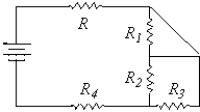
A) R2 and R3
B) R and R1
C) R2 and R4
D) R and R4

A) R2 and R3
B) R and R1
C) R2 and R4
D) R and R4

Unlock Deck
Unlock for access to all 115 flashcards in this deck.
Unlock Deck
k this deck
47
When a 24.0- resistor is connected across a 12.0-V battery, a current of 410 mA flows. What is the internal resistance of the battery?
A) 29.3
B) 0.9
C) 5.3
D) 0.02
A) 29.3
B) 0.9
C) 5.3
D) 0.02

Unlock Deck
Unlock for access to all 115 flashcards in this deck.
Unlock Deck
k this deck
48
Three resistors connected in parallel each carry currents labeled I1, I2, and I3. Which of the following expresses the value of the total current IT in the combined system?
A) IT = (1/I1 + 1/I2 + 1/I3)
B) IT = I1 = I2 = I3
C) IT = I1 + I2 + I3
D) IT = (1/I1 + 1/I2 + 1/I3) - 1
A) IT = (1/I1 + 1/I2 + 1/I3)
B) IT = I1 = I2 = I3
C) IT = I1 + I2 + I3
D) IT = (1/I1 + 1/I2 + 1/I3) - 1

Unlock Deck
Unlock for access to all 115 flashcards in this deck.
Unlock Deck
k this deck
49
Three resistors, each with resistance R1, are in series in a circuit. They are replaced by one equivalent resistor, R. Comparing this resistor to the first resistor of the initial circuit, which of the following is true?
A) The voltage across R equals the voltage across R1.
B) The current through R equals the current through R1.
C) The power given off by R equals the power given off by R1.
D) R is less than R1.
A) The voltage across R equals the voltage across R1.
B) The current through R equals the current through R1.
C) The power given off by R equals the power given off by R1.
D) R is less than R1.

Unlock Deck
Unlock for access to all 115 flashcards in this deck.
Unlock Deck
k this deck
50
Which resistor is in series with resistor R? 
A) R3
B) R4
C) R1
D) R2

A) R3
B) R4
C) R1
D) R2

Unlock Deck
Unlock for access to all 115 flashcards in this deck.
Unlock Deck
k this deck
51
Three resistors connected in series each carry currents labeled I1, I2, and I3. Which of the following expresses the value of the total current IT in the system made up of the three resistors in series?
A) IT = I1 + I2 + I3
B) IT = (1/I1 + 1/I2 + 1/I3) - 1
C) IT = (1/I1 + 1/I2 + 1/I3)
D) IT = I1 = I2 = I3
A) IT = I1 + I2 + I3
B) IT = (1/I1 + 1/I2 + 1/I3) - 1
C) IT = (1/I1 + 1/I2 + 1/I3)
D) IT = I1 = I2 = I3

Unlock Deck
Unlock for access to all 115 flashcards in this deck.
Unlock Deck
k this deck
52
Three 3.0- resistors are connected in parallel to a 12.0-V battery. What is the current in any one of the resistors?
A) 0.75 A
B) 12 A
C) 4.0 A
D) 1.3 A
A) 0.75 A
B) 12 A
C) 4.0 A
D) 1.3 A

Unlock Deck
Unlock for access to all 115 flashcards in this deck.
Unlock Deck
k this deck
53
A solar panel measures 80 cm * 50 cm. In direct sunlight, the panel delivers 4.8 A at 15 V. If the intensity of sunlight is 1000 W/m2, what is the efficiency of the solar panel in converting solar energy into electrical energy?
A) 12%
B) 24%
C) 18%
D) 6.0%
A) 12%
B) 24%
C) 18%
D) 6.0%

Unlock Deck
Unlock for access to all 115 flashcards in this deck.
Unlock Deck
k this deck
54
Two resistors of values 6.0 and 12.0 are connected in parallel. This combination in turn is hooked in series with an 8.0- resistor and a 24-V battery. What is the current in the 12- resistor?
A) 1.3 A
B) 4.0 A
C) 12 A
D) 0.67 A
A) 1.3 A
B) 4.0 A
C) 12 A
D) 0.67 A

Unlock Deck
Unlock for access to all 115 flashcards in this deck.
Unlock Deck
k this deck
55
Three resistors connected in parallel have individual values of 4.0, 6.0, and 10.0 , respectively. If this combination is connected in series with a 12-V battery and a 2.0- resistor, what is the current in the 6.0- resistor? 
A) 0.98 A
B) 16 A
C) 0.59 A
D) 11 A

A) 0.98 A
B) 16 A
C) 0.59 A
D) 11 A

Unlock Deck
Unlock for access to all 115 flashcards in this deck.
Unlock Deck
k this deck
56
Kirchhoff's rules are the junction rule and the loop rule. Which of the following statements is true?
A) The junction rule is based on the conservation of charge, and the loop rule is based on the conservation of energy.
B) The junction rule is based on the conservation of energy, and the loop rule is based on the conservation of charge.
C) Both rules are based on the conservation of charge.
D) Both rules are based on the conservation of energy.
A) The junction rule is based on the conservation of charge, and the loop rule is based on the conservation of energy.
B) The junction rule is based on the conservation of energy, and the loop rule is based on the conservation of charge.
C) Both rules are based on the conservation of charge.
D) Both rules are based on the conservation of energy.

Unlock Deck
Unlock for access to all 115 flashcards in this deck.
Unlock Deck
k this deck
57
Three resistors connected in parallel have the individual voltages labeled V1, V2, and V3, respectively. Which of the following expresses the total voltage VT across the three resistors when connected in this manner?
A) " VT = (1/ V1 + 1/ V2 + 1/ V3)"
B) " VT = V1 + V2 + V3"
C) " VT = (1/ V1 + 1/ V2 + 1/ V3) - 1"
D) " VT = V1 = V2 = V3"
A) " VT = (1/ V1 + 1/ V2 + 1/ V3)"
B) " VT = V1 + V2 + V3"
C) " VT = (1/ V1 + 1/ V2 + 1/ V3) - 1"
D) " VT = V1 = V2 = V3"

Unlock Deck
Unlock for access to all 115 flashcards in this deck.
Unlock Deck
k this deck
58
When a 24.0- resistor is connected across a 12.0-V battery, a current of 410 mA flows. What is the resulting terminal voltage of the battery?
A) 11.6 V
B) 9.8 V
C) 0.4 V
D) 12.0 V
A) 11.6 V
B) 9.8 V
C) 0.4 V
D) 12.0 V

Unlock Deck
Unlock for access to all 115 flashcards in this deck.
Unlock Deck
k this deck
59
Three resistors connected in series have individual voltages labeled V1, V2, and V3, respectively. Which of the following expresses the value of the total voltage VT taken over the three resistors together?
A) " VT = (1/ V1 + 1/ V2 + 1/ V3)"
B) " VT = V1 = V2 = V3"
C) " VT = (1/ V1 + 1/ V2 + 1/ V3) - 1"
D) " VT = V1 + V2 + V3"
A) " VT = (1/ V1 + 1/ V2 + 1/ V3)"
B) " VT = V1 = V2 = V3"
C) " VT = (1/ V1 + 1/ V2 + 1/ V3) - 1"
D) " VT = V1 + V2 + V3"

Unlock Deck
Unlock for access to all 115 flashcards in this deck.
Unlock Deck
k this deck
60
Four 8.0- resistors are connected in parallel. What is their equivalent resistance?
A) 4.0
B) 0.50
C) 2.0
D) 32
A) 4.0
B) 0.50
C) 2.0
D) 32

Unlock Deck
Unlock for access to all 115 flashcards in this deck.
Unlock Deck
k this deck
61
If R1 < R2 < R3, and if these resistors are connected in parallel in a circuit, which one has the highest current?
A) R2
B) R1
C) All have the same current.
D) R3
A) R2
B) R1
C) All have the same current.
D) R3

Unlock Deck
Unlock for access to all 115 flashcards in this deck.
Unlock Deck
k this deck
62
If I1 goes to the right through R1, I2 goes to the right through R2, and I3 goes to the left through R3, what is the resulting equation resulting from applying Kirchhoff's junction rule at point b? 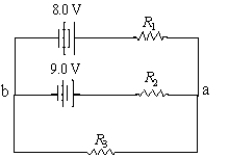
A) I1 - I2 - I3 = 0
B) I1 - I2 + I3 = 0
C) I1 + I2 + I3 = 0
D) I1 + I2 - I3 = 0

A) I1 - I2 - I3 = 0
B) I1 - I2 + I3 = 0
C) I1 + I2 + I3 = 0
D) I1 + I2 - I3 = 0

Unlock Deck
Unlock for access to all 115 flashcards in this deck.
Unlock Deck
k this deck
63
What is the potential difference between points a and b? 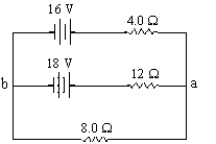
A) 24 V
B) 6 V
C) 8 V
D) 12 V

A) 24 V
B) 6 V
C) 8 V
D) 12 V

Unlock Deck
Unlock for access to all 115 flashcards in this deck.
Unlock Deck
k this deck
64
If = 9.0 V, what is the current in the 30- resistor? 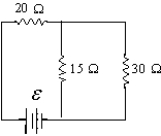
A) 0.30 A
B) 0.26 A
C) 0.10 A
D) 0.20 A

A) 0.30 A
B) 0.26 A
C) 0.10 A
D) 0.20 A

Unlock Deck
Unlock for access to all 115 flashcards in this deck.
Unlock Deck
k this deck
65
Three resistors, each with resistance R1, are in parallel in a circuit. They are replaced by one equivalent resistor, R. Compare this resistor to the first resistor of the initial circuit. Which of the following statements is true?
A) The current through R equals the current through R1.
B) R is greater than R1.
C) The power given off by R equals the power given off by R1.
D) The voltage across R equals the voltage across R1.
A) The current through R equals the current through R1.
B) R is greater than R1.
C) The power given off by R equals the power given off by R1.
D) The voltage across R equals the voltage across R1.

Unlock Deck
Unlock for access to all 115 flashcards in this deck.
Unlock Deck
k this deck
66
Resistors of values 6.0 , 4.0 , 10.0 and 7.0 are combined as shown. What is the equivalent resistance for this combination? 
A) 2.3
B) 27
C) 10.7
D) 3.0

A) 2.3
B) 27
C) 10.7
D) 3.0

Unlock Deck
Unlock for access to all 115 flashcards in this deck.
Unlock Deck
k this deck
67
If I1 goes to the right through R1, I2 goes to the right through R2, and I3 goes to the left through R3, what is the resulting equation resulting from applying Kirchhoff's loop rule for a clockwise loop around the perimeter of the circuit? 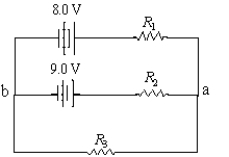
A) 8.0 V - I1R1 + I3R3 = 0
B) 8.0 V - I1R1 - I3R3 = 0
C) 8.0 V + I1R1 + I3R3 = 0
D) -8.0 V - I1R1 + I3R3 = 0

A) 8.0 V - I1R1 + I3R3 = 0
B) 8.0 V - I1R1 - I3R3 = 0
C) 8.0 V + I1R1 + I3R3 = 0
D) -8.0 V - I1R1 + I3R3 = 0

Unlock Deck
Unlock for access to all 115 flashcards in this deck.
Unlock Deck
k this deck
68
How much current is flowing in the 2- resistor? 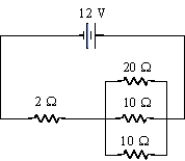
A) 0.8 A
B) 2.4 A
C) 1.6 A
D) 2.0 A

A) 0.8 A
B) 2.4 A
C) 1.6 A
D) 2.0 A

Unlock Deck
Unlock for access to all 115 flashcards in this deck.
Unlock Deck
k this deck
69
Consider the circuit shown in the figure. What power is dissipated by the top 5- resistor? 
A) 14 W
B) 112 W
C) 17 W
D) 52 W

A) 14 W
B) 112 W
C) 17 W
D) 52 W

Unlock Deck
Unlock for access to all 115 flashcards in this deck.
Unlock Deck
k this deck
70
What is the current through the 6- resistor? 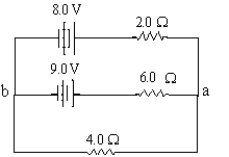
A) 1.0 A
B) 1.5A
C) 0.50 A
D) 2.0 A

A) 1.0 A
B) 1.5A
C) 0.50 A
D) 2.0 A

Unlock Deck
Unlock for access to all 115 flashcards in this deck.
Unlock Deck
k this deck
71
What is the current flowing through the 8- resistor? 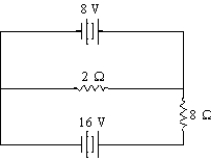
A) 6 A
B) 4 A
C) 2 A
D) 1 A

A) 6 A
B) 4 A
C) 2 A
D) 1 A

Unlock Deck
Unlock for access to all 115 flashcards in this deck.
Unlock Deck
k this deck
72
Five resistors each have resistance R. Three of the resistors are connected in series and this combination is then connected in parallel with the two other resistors which have been connected in series with each other. What is the equivalent resistance for this arrangement?
A)
B)
C)
D)
A)

B)

C)

D)


Unlock Deck
Unlock for access to all 115 flashcards in this deck.
Unlock Deck
k this deck
73
In the circuit segment shown if I = 8.0 mA and Q = 75 µC, what is the potential difference, VA - VB? 
A) "-35 V"
B) "+15 V"
C) "-15 V"
D) "+35 V"

A) "-35 V"
B) "+15 V"
C) "-15 V"
D) "+35 V"

Unlock Deck
Unlock for access to all 115 flashcards in this deck.
Unlock Deck
k this deck
74
Resistors of values 8.0 , 12.0 , and 24.0 are connected in parallel across a fresh battery. Which resistor dissipates the least power?
A) the 24.0- resistor
B) All dissipate the same power when in parallel.
C) the 12.0- resistor
D) the 8.0- resistor
A) the 24.0- resistor
B) All dissipate the same power when in parallel.
C) the 12.0- resistor
D) the 8.0- resistor

Unlock Deck
Unlock for access to all 115 flashcards in this deck.
Unlock Deck
k this deck
75
A battery has an internal resistance  . Connecting a wire of negligible resistance between the terminals of the battery draws the maximum current
. Connecting a wire of negligible resistance between the terminals of the battery draws the maximum current  from this battery. If instead a resistor is connected between the terminals, a smaller current is produced. What value resistor placed across the terminals would result in the current produced to be half of
from this battery. If instead a resistor is connected between the terminals, a smaller current is produced. What value resistor placed across the terminals would result in the current produced to be half of  ?
?
A)
B)
C)
D)
 . Connecting a wire of negligible resistance between the terminals of the battery draws the maximum current
. Connecting a wire of negligible resistance between the terminals of the battery draws the maximum current  from this battery. If instead a resistor is connected between the terminals, a smaller current is produced. What value resistor placed across the terminals would result in the current produced to be half of
from this battery. If instead a resistor is connected between the terminals, a smaller current is produced. What value resistor placed across the terminals would result in the current produced to be half of  ?
?A)

B)

C)

D)


Unlock Deck
Unlock for access to all 115 flashcards in this deck.
Unlock Deck
k this deck
76
What is the equivalent resistance for these 3.00- resistors? 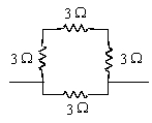
A) 2.25
B) 3.00
C) 1.33
D) 7.50

A) 2.25
B) 3.00
C) 1.33
D) 7.50

Unlock Deck
Unlock for access to all 115 flashcards in this deck.
Unlock Deck
k this deck
77
If I = 1.0 mA and the potential difference, VA - VB = +30 V in the circuit segment shown, determine the charge and polarity of the capacitor. 
A) 1.0 mC, left plate is positive
B) 3.5 mC, right plate is positive
C) 3.5 mC, left plate is positive
D) 1.0 mC, right plate is positive

A) 1.0 mC, left plate is positive
B) 3.5 mC, right plate is positive
C) 3.5 mC, left plate is positive
D) 1.0 mC, right plate is positive

Unlock Deck
Unlock for access to all 115 flashcards in this deck.
Unlock Deck
k this deck
78
If = 20 V, at what rate is thermal energy being generated in the 40- resistor? 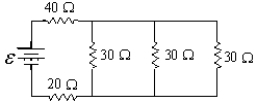
A) 26 W
B) 1.6 W
C) 3.3 W
D) 15 W

A) 26 W
B) 1.6 W
C) 3.3 W
D) 15 W

Unlock Deck
Unlock for access to all 115 flashcards in this deck.
Unlock Deck
k this deck
79
Four 1.5-volt AA batteries in series power a transistor radio. If the batteries hold a total charge of 440 C, how long will they last if the radio has a resistance of 200 ?
A) 4.1 h
B) 2.2 h
C) 1.1 h
D) 13 h
A) 4.1 h
B) 2.2 h
C) 1.1 h
D) 13 h

Unlock Deck
Unlock for access to all 115 flashcards in this deck.
Unlock Deck
k this deck
80
What is Kirchhoff's 1st equation for this junction? 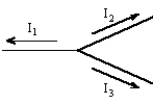
A) I1 + I2 + I3 = 0
B) I2 = I1+ I2
C) I3 = I1 + I2
D) I1 = I2 + I3

A) I1 + I2 + I3 = 0
B) I2 = I1+ I2
C) I3 = I1 + I2
D) I1 = I2 + I3

Unlock Deck
Unlock for access to all 115 flashcards in this deck.
Unlock Deck
k this deck



